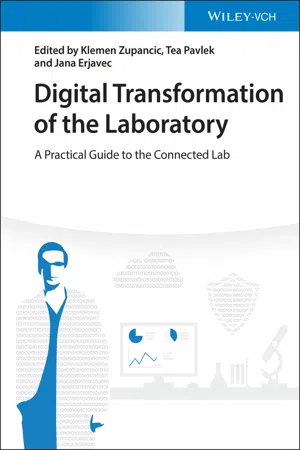
Digital Transformation of the Laboratory
A Practical Guide to the Connected Lab
- English
- ePUB (mobile friendly)
- Available on iOS & Android
Digital Transformation of the Laboratory
A Practical Guide to the Connected Lab
About this book
Take your lab into the 21st century with this insightful and exciting new resource
Digital Transformation of the Laboratory: A Practical Guide to the Connected Lab delivers essential and transformative new insights into current and future technologies and strategies for the digitization of laboratories. Thoroughly supported and backed-up with contributions from thought and industry leaders, the book shows scientists in academia and industry how to move from paper to digital in their own labs.
The distinguished editors have included resources from industry-leading voices in their respective fields that offer concrete and practical strategies to embrace modern, digital technology. You'll learn to modernize your laboratory, cut costs, improve productivity, and find efficiencies you never considered.
You'll discover a stepwise approach to move from paper to digital tech, including guidance on how to understand and define your lab's requirements and evaluate potential solutions. Real-world case studies are included throughout the book to provide specific examples of how the ideas presented in the book can be applied in real life. You'll also benefit from the inclusion of:
- A thorough introduction to the evolution of the modern laboratory, including new available technologies and the new science being conducted with it
- An exploration of crucial terms you'll need to understand in order to chart your path into the future of the laboratory
- Examinations of practical issues you'll need to master in order to define your lab's digitalization strategy
- Numerous case studies and expert commentary on the subject of moving from paper to digital
Perfect for senior executives, lab managers, senior scientists, principal investigators, professors and PhDs working in the field of biotechnology, pharma, chemistry, healthcare, life science, Digital Transformation of the Laboratory: A Practical Guide to the Connected Lab will also earn a place in the libraries of laboratory heads and auditing departments seeking to find efficiencies, cut costs, and maximize productivity in their own labs.
Frequently asked questions
- Essential is ideal for learners and professionals who enjoy exploring a wide range of subjects. Access the Essential Library with 800,000+ trusted titles and best-sellers across business, personal growth, and the humanities. Includes unlimited reading time and Standard Read Aloud voice.
- Complete: Perfect for advanced learners and researchers needing full, unrestricted access. Unlock 1.4M+ books across hundreds of subjects, including academic and specialized titles. The Complete Plan also includes advanced features like Premium Read Aloud and Research Assistant.
Please note we cannot support devices running on iOS 13 and Android 7 or earlier. Learn more about using the app.
Information
Part I
Inspiration
1
The Next Big Developments – The Lab of the Future
1.1 Introduction
1.2 Discussion
- People and culture considerations
- Process developments and optimization
- Data management improvements
- Lab environment and design

1.2.1 People/Culture
1.2.2 Process

Table of contents
- Cover
- Table of Contents
- Title Page
- Copyright
- Preface
- Part I: Inspiration
- Part II: Knowledge Base
- Part III: Practical
- Part IV: Case Studies
- Part V: Continuous Improvement
- Part VI: Vision of the Future and Changing the Way We Do Science
- Index
- End User License Agreement